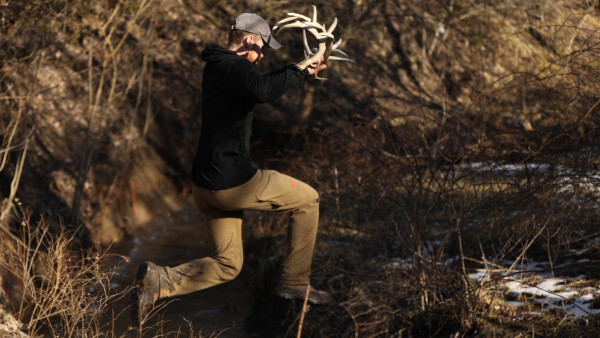
The best time to shed hunt is any day or weekend or week that you can get off work or away from other obligations to race away to the woods. But the next best time is when conditions are perfect.
As I’ve written before, consistent shed hunting success is strongly linked to efficiency, i.e. making the most of your precious hours in the field and hard-earned miles. A rarely discussed but useful ways to do this, if you have a flexible schedule, is to time your shed hunts with when conditions are ideal for actually seeing antlers. Here’s a quick rundown of exactly what those best conditions look like and how you can use this information to better choose the dates you go in search of bone.
Snow Cover Too much snow is an obvious issue, because you can’t find sheds if they’re covered by a foot-deep blanket of frozen ice crystals. In a perfect world I like to shed hunt when most, if not all, the snow is melted. Not only can snow cover sheds but it also hides antlers against the white background. Conversely, a recently melted drab brown and green post-snow landscape provides a contrast that makes antlers really pop.
That said, there is a case to be made for searching in a little snow. For example, when there’s light snow on the ground you can better see areas of high deer activity highlighted by their tracks and beds that are easily visible in snow but hidden on bare ground. You can also follow specific trails in the snow and find antlers lying in them. If you know where the most deer are hanging out, you’ll know where to focus your shed hunting efforts. This is no small thing.
For that reason, shed hunting diehard Jeremy Moore prefers some snow cover. “If I can time my hunts when the snow is melting but not gone completely, I can streamline the percentage of woods I have to cover,” he said. “Where the snow melts first in the direct sun is a good spot to find beds and, consequently, sheds.”
In summary, you want no snow at all or just enough to see deer sign in key areas but not cover antlers.
Sun The next condition to consider is sunlight. Finding sheds is a sight game, so the sun obviously has a major impact on what you can see. Get a bright sunny day and you might be squinting for hours on end, leading to eye fatigue or not being able to see antlers against a blown-out-bright background. This is especially true if there’s snow on the ground. Good polarized sunglasses are a must if you find yourself shed hunting in conditions like this, said Shane Indrebo, co-owner of the North American Shed Hunters Club. If we turn down the sun a bit by adding scattered clouds, we still have a problem. Partly cloudy days can lead to a dappled, contrasting collage of sun and shadow on the ground which also leads to less-than-ideal sighting conditions.
The perfect situation for scanning a landscape for hours on end in search of an antler is a consistent, non-stressful backdrop on which white bone stands out in stark contrast. This means dull, gray, cloudy weather. “I prefer overcast days,” Indrebo agreed. “The antlers are easier to see, and the lighting isn’t harsh or creating shadows.”
Moore has seen the same benefits with these conditions. “On a cloudy day, my eyes are less stressed and colors on the landscape are not as contrasting from dark shadows or direct sunlight,” he said. “The antlers stick out more to me when the sun isn’t casting shadows that look like potential tines.”
Moisture The last element worth considering is moisture. Many shed hunters love to get out on days with a light drizzle or just after a rain when the ground and antlers are still wet. The rain-covered surface of antler produces just a little extra sheen, which some believe makes them a little more noticeable. “An antler that is damp or wet on a cloudy day will really stand out visually,” Moore said. “They almost shine or glow, particularly against a wet, dark forest floor.”
Another variable even fewer folks consider is the impact that moisture can have on a dog's ability to sniff out an antler. Moore, also a professional shed dog trainer, sees this as a crucial aspect if you’re one of the ever-increasing number of shed hunters who uses a canine to help fuel your antler addiction. “Moisture allows scent to be created and magnified and is also necessary for my dogs’ noses to process scent clues,” he said. “On dry, windy days, the ground, along with the air, is typically dry and very challenging for the dogs.”
Time If you’re the lucky man or woman who can be choosy about the days you go shed hunting, do your best to pick your shots when the above conditions line up favorably. You’ll find more antlers per hour or mile than you would otherwise.
But please, for the love of powder-white tines and red pedicles, do not use this as an excuse to not go shed hunting at all. Even if the conditions aren’t ideal, one day spent outside is better than a week of TV on the couch. Get out there. Give it a shot. Have some fun. Life’s too short to sit around waiting for tomorrow.








Conversation